
The inspiration for this Angel came from childhood crafting days, but not mine. If you have read "About Me", you
will already know that I was an elementary school teacher for 34 years. On our classroom supply order sheet, we used to be able to order paper doilies by the hundreds for just pennies.
Of course they were always in plentiful supply at Valentine's Day, but we also used them to make these angels. Heart ones for the wings, square ones for the arms and top, and
just white paper folded like a paper fan, eventually turned into a lovely little lady (simple but very effective looking). I also used to make large ones out of experience chart paper and we used those, holding song books,
to decorate the gym for the Holiday Sing-a-Long.

What You Will Need to Start
...PSP 6 or 7 (this was done in 6)...
Visit JASC to download a free trial
...Redfield's Jama 3D that you can download here...
...my zip file of a psp file of the heart shape, pspfile of the daisy petal shape and the bladepro setting that you can download here...
I want to give special thanks to Mardi from
Web Graphics on a Budget for being kind enough to grant me permission to include her setting in my zip download here. It is
called "cutout" and one I have used constantly and just love what it does. If you click
here, this leads you to her page to read about the cutout effect.
Thank you again, Mardi, for your generosity.
Start by unzipping and installing your bladepro "cutout" so it will be ready for use.
We are going to start on the wings first, so open the heart shape file, duplicate it, then close the original
for future use.
Create a new raster layer on the heart image. Open the daisy petal shape. You need to copy it and then we will be pasting it around the heart shape. Please leave it black and we will take care of that later. Start in the top centre of the
heart and paste one daisy. I judged the placement by putting the centre circle of the daisy half on and half off the heart. (That is why the black is being used now to help make placement easier to see.) Work your way around
both sides of the heart. If they don't meet exactly at the bottom, don't worry because that part will be hidden.
When all daisies are in place, go to "colours - negative" and your black daisies will turn into white ones. Using the selection tool, set to rectangle, surround your daisies, then click
inside so the marching ants appear around each little daisy. Then go to Bladepro and find the "cutout". When you have selected it, you need to do one step before applying the effect to your
daisies. On the settings at the left, look up to the second from the top - "Height". Right now the setting is at -100 (minus 100). This is what you would normally use for a cutout effect. We need to change that so move the height slider all the way to the
right until it reaches +100. This gives you a puffed up look and personally, I use this effect a lot on lettering rather than an inner bevel. Now you can apply the effect and your daisies will hopefully look like the
decorations around the outside of a real paper doily. Finish off here by going to "layers - merge visible". Hide this at the bottom of your screen until later. You can also save it as "wing.psp" just in case anything happens and you lose it.
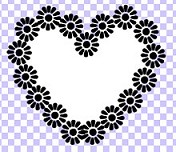
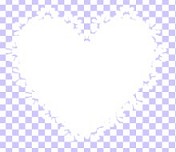
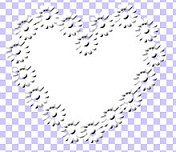
We need to open a new image, 400 by 400, transparent, 16 mil colours. Give it a name and save it as psp before you start. Then
remember to save often. Set your colours to the two listed below for the skin colour and shadowing or any colours of your own choosing as a skin colour.
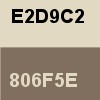
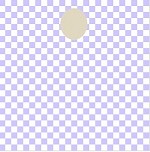
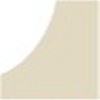
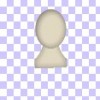
Create a new raster layer called "head". Using the shape tool set to ellipse, draw a head shape near the top of the image. Leave room for just a bit of hair. Select your shape to have ants appear surrounding it, then go to "selections - invert"
and apply a drop shadow using the darker brown and settings of - Opacity.....40 Blur.....20 V and H.....4. Then repeat switching V and H to minus 4. Deselect.
Create a new raster layer called "neck". The explanation that follows is how I did the neck. There may be easier ways, but this is my way. Draw a rectangle, your flesh colour, anywhere, because we will be moving it. Using the selection tool set to ellipse, try and have the bottom of the ellipse overlap part of your
rectangle. Then hit the delete key or the scissors to remove this area. See the third image above. Select this shape, then copy and paste on the same layer, and then image-mirror. Overlap the two until you get a nice neck shape. Select this new neck shape, go to selections - invert and apply the same drop shadow as you did to the head. Then arrange this layer down behind the head and move it into the correct
place. See the last image above.
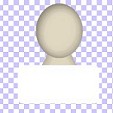
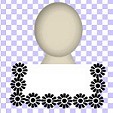
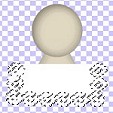
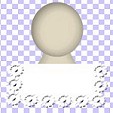
Create a new raster layer named "collar" and move to the top. Using the shape tool, draw a white rounded rectangle to act as the collar. See first image above. Create a new raster layer and follow the exact steps we did for the heart wings. Add the black daisies reduced to 75% of the original,
colour negative, select, add bladepro "cutout" effect. At this point you can hide all the other layers except these two and merge - visible and rename "collar".
We are now going to open another new image, 300 by 300, 16 mil colours, transparent. We are going to make the skirt.
Add a new raster layer and floodfill with white. Go to effects - Jama 3D. Set it up as per the settings below then apply.
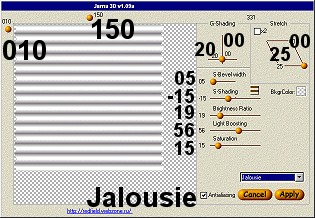
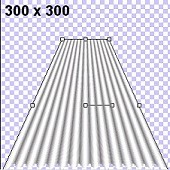
The folds are going in the wrong direction, so go to image- rotate -right - 90 degrees.
Click on the deformation tool. Check the picture above right. Hold down the control key then drag either the upper right or left box inwards
towards the centre but not all the way so they meet. Then release the control key, grab the top middle box and pull downwards a little.
Apply the deformation then go to image - sharpen - sharpen. Copy the image, then return to the main image and paste as a new layer. Name it "skirt". Move it down under the
collar layer.
In my next illustrations, I have added a blue background to make it easier for viewing.
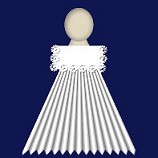
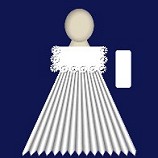
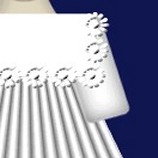
Create a new raster layer called "right arm".
Using the shape tool, draw a white rounded rectangle to represent an arm. Select it, then go to selections - invert and
add a drop shadow using... black... Opacity...40, Blur 10..... V and H...2, then repeat using V and H...minus 2. Make sure this layer is
above the skirt layer and below the collar layer. To make turning it easier, I always use the deformation tool to twist and move. Check the image above for
the arm placement. When happy with it, duplicate this layer and then image - mirror. You might have to adjust the left arm because we
did not start our image exactly in the centre. Name this layer "left arm".
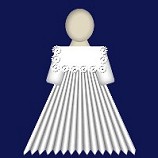

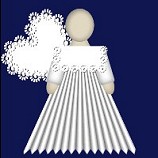
Create a new raster layer called "right hand", and using the shape tool and your flesh colour, draw a small ellipse that will represent a hand. Select it, go to selections - invert and apply the same drop shadows as you did for the arm.
Then move the layer down until it is just under the arm. Rotate it a little to match up with the tilt of the arm. Then duplicate this layer and then image - mirror for the other hand. Adjust if you have to. Call this layer "left hand".
On your layer list, click on the very bottom one, then add a new raster layer called "left wing". Open up your heart wing that has been waiting at the bottom of your screen. Copy the image, then
paste as a selection on your newly created layer. Click on the deformation tool or image - rotate area and adjust the wing to the left and move it under the body. Check the last image above.
When satisfied, duplicate the layer and image - mirror for the other wing and adjust the placement if needed. Name this layer "right wing".
I left the drop shadows until this point and that is why you have not been told to merge layers.
You will need to add drop shadows to several layers now. These have been applied to the hand layers, arm layers, collar, and head.
On each layer mentioned, apply a drop shadow using black, opacity 40, blur 10. Looking at the image, apply to the left hand, left arm, collar, and head... a vertical and
horizontal of 4. Using the same opacity and blur, apply a drop shadow switching the vertical and horizontal to -4 on the
right arm and right hand. At this point I felt that the collar looked a little funny with the drop shadow added, so I made an adjustment to the neckline. You can leave yours as is, if you wish. If
you also wish to switch it, go to the collar layer. Choose the selection tool set to ellipse, and starting above the collar, pull out the ellipse shape until it makes a little round neckline, then hit the scissors or the delete key.
This is the same step you did to form the neck at the beginning.
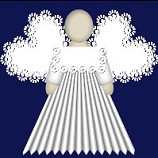
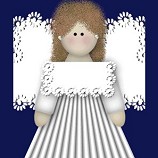
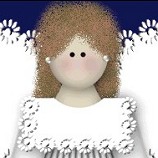
I will admit that I am not good on faces or hair. What I did here, was use the spray can set to size 50, opacity 100, density 50,
and using two shades of brown, I created a new layer just above the wings called "back hair" and sprayed short bursts to represent hair coming down behind her back. Then I created a new layer called "front hair" on top
of the face layer and sprayed down from the centre to the left then right just to about the ear level. Then I added a pearl tube for earrings. I will not be offended if you
want to change her hair and face to what is your liking. For the face, I created a new layer on top and just added two small black circles for eyes, then created another new layer "blush" and sprayed a pretty pink using the same settings as for the hair, then applied a gaussian blur
of 5.00 for her cheeks.
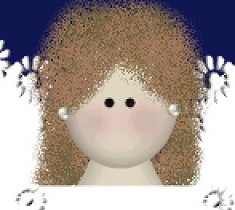
The last step is to create another new layer called "wire" just below both the hand layers. I used the rope tube set to 15 and drew a squiggly line then added tube stars. Here again, you have the option
of adding to the wire anything you would like.
Your angel is now completed. You can merge visible layers and tube or save in layers as a psp file in case you want
to make her a Valentine angel holding hearts, or an Easter angel holding eggs, or a St. Patrick's angel holding shamrocks.
If you have any problems or need further explanations, please feel free to email me here
MAIN TUTORIAL LIST
This tutorial was posted at the site of "P. Ann's Place" Dec. 17, 2001 and written
by Pat Sherman.
All I ask is that you do not claim it as your own.
|
|